<<< Previous diary post on the BP-building project
Wednesday 2019-05-29: It is closing in on me
Finally, after several days of waiting, it is almost time for launch.
On the day before Ascension day, my sister Jennie flies down from Luleå in the northern parts of Sweden and we meet at my house to prepare for this season’s first weekend of paddling by our summer house in the archipelago of Blekinge.
And above all, preparing for the maiden voyage of the Pearl!
Anticipation is tense, will I be able to keep myself on top of things (primarily the kayak), or will it be a weekend of fruitless bathing exercises? Actually, I don’t have a clue as to how it will turn out, wine or water?
Did I place the right bet when hoping that Black Pearl would be a reasonable challenge for me as a kayaker or will I be in over my head?
And in case of the latter, precisely how much water will there be over my head?
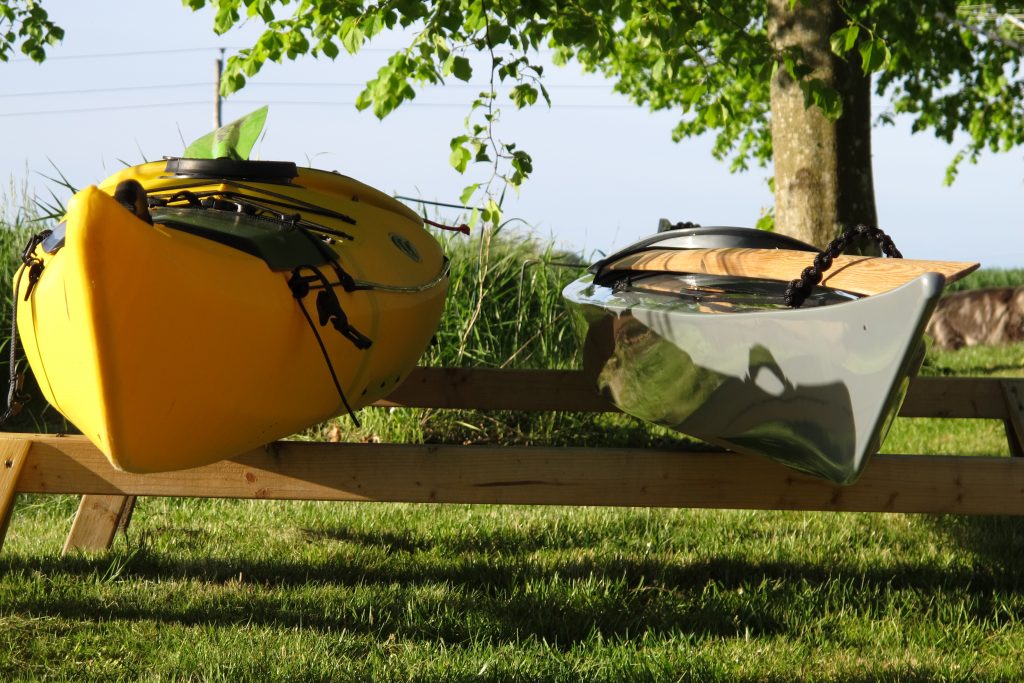
Touryak 470 LV (to the left) versus Black Pearl (to the right).
The designation LV – Low Volume – seems a bit misleading in this context.
But, as Einstein said, everything is…
Thursday 2019-05-30: Maiden voyage
Arriving in Blekinge, the weather is not the best, but not the worst either. Winds would be about 8-10 m/s according to the forecast, 14-15 in the gusts. Not optimal for a first try in a kayak assumed not to be the most stable one.
But we are inshore in the archipelago and leewards of a helpful cape just below our house. Strolling a few lengths back and forth by the shore is all I ask for right now, to get an indication of how the rest of the weekend will emerge. Above or below the kayak?
Even if it is end of May, there is no particular warmth in the water, nor in the air. Since I anticipate beeing in the water more than in the kajak, I slip into my dry suit. Don’t want to quit immediately even if things tip over now and then. Apart from that, I am also a notorious coward when it comes to bathing.
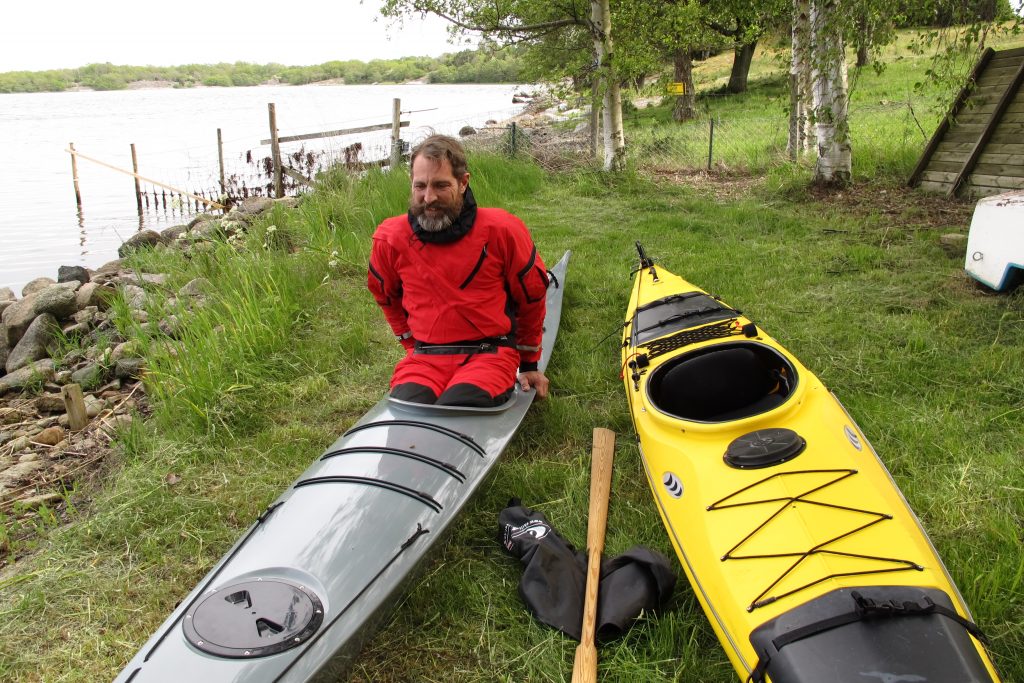
Photo: Jennie Sjöholm
The neoprene shoes used for protection over my dry suit socks turn out to make entry even more dificult. Their rubber sole covers also the heel and toes and the friction against the flooring requires a lot of fiddeling to overcome in order to get the legs into the intended position under the fore deck.
What seems even more disturbing is that quite a lot of force and jiggeling is required also when pulling the legs out during exit. This could pose a significatn safety issue.
This needs to be resolved somehow. I don’t want to do without the neoprene socks but I would not like to get stuck upside down in the cockpit of a capsized kayak either.
Nevertheless, into the water.

Photo: Jennie Sjöholm
Initially, my reflexes, in their misguided effort to maintain balance, revert to spastic overcompensations at the slightest leaning of the boat.
Pretty soon however, it is possible to relax a bit which makes things a lot less risky. But to look over the shoulder is definitively not the right move to try just yet.
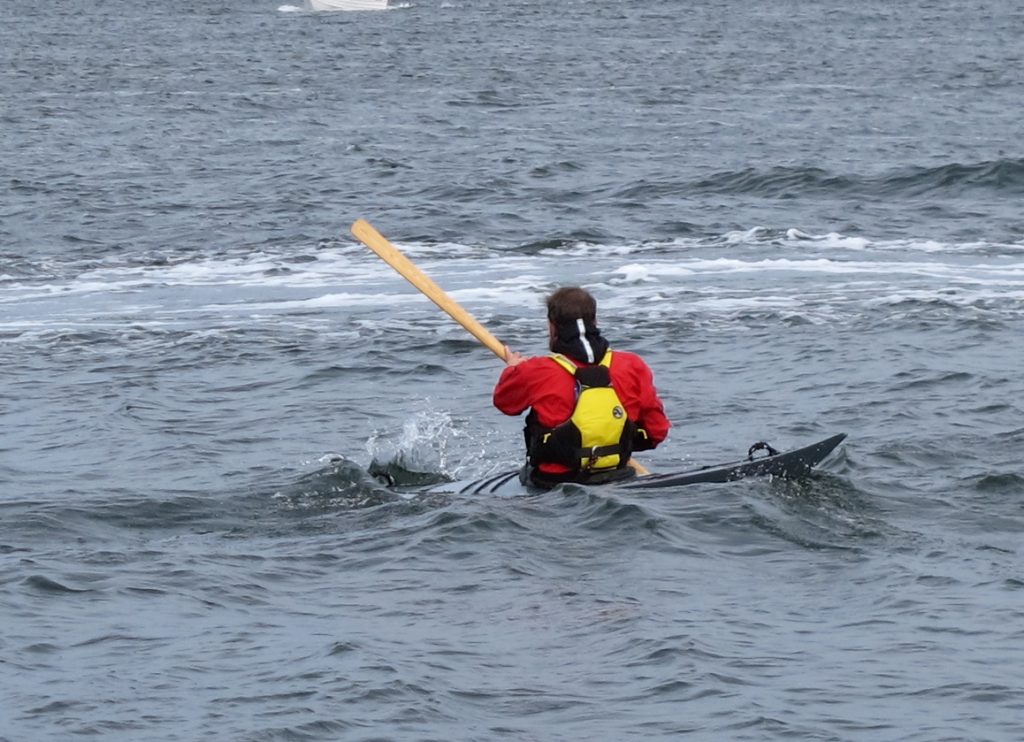
Photo: Jennie Sjöholm
After som idle paddling back and forth, I get an impulse to check how far you can lean over without capsizing. More than you would believe, but eventually we turn over, obviously.
My plan for this first trial did not include any roll attempt, but that plan went out of the window when I decided to evaluate maximum leaning capability. So now I can do nothing else but try to get the top-side uppermost again.
Easy peasy, a walk in the park. I haven’t executed a roll since last summer, and my rolling skills is not that much to brag about from the beginning. But in the Pearl even the clumsiest of efforts seems to be successful. Tried out a few more just to make sure it wasn’t mere beginners luck the first time.
Of course I had anticipated the Pearl to be a competent rolling machine, but this was a far better experience than I have dared to hope for.
My biggest concern in relation to rolling has probably been that I wouldn’t be able to control the balance coming up from a roll, but immediately fall over on the other side. But there were no such tendencies. Okay, there wasn’t a wave anywhere to be found, but at least it doesn’t look explicitly bad when anticipating the future.
I even nailed three out of the three butterfly rolls I tried, a type of roll I have only managed to complete one single time in the pre-BP era.
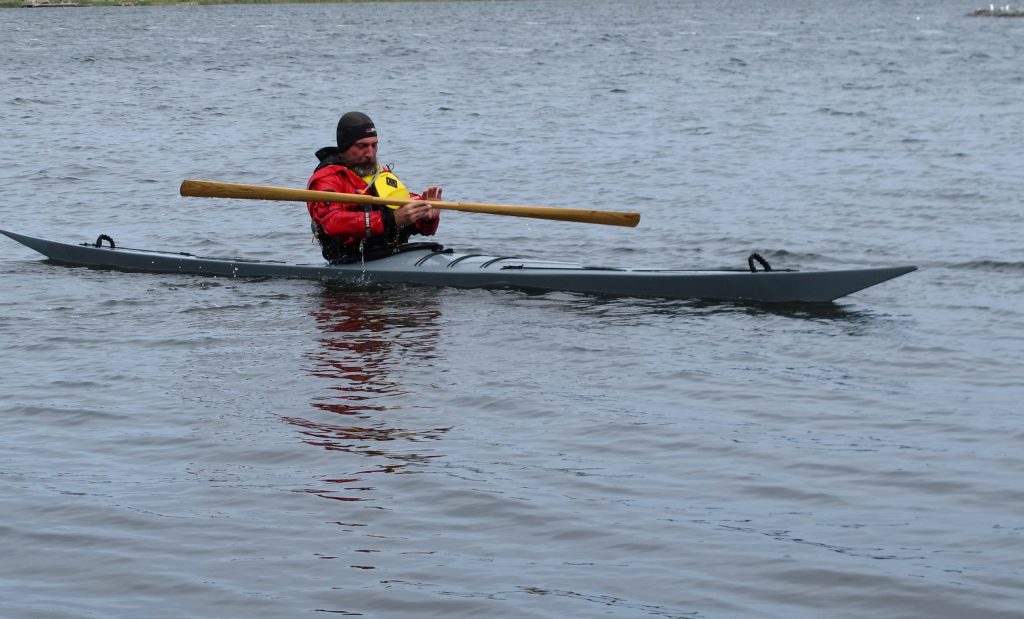
Photo: Jennie Sjöholm
Time to close this opening session while I still have the upper hand.

Photo: Jennie Sjöholm
I realise with some amazement that I have still never capsized involontarily with a kayak. This would otherwise have been an obvious opportunity for breaking that suite.
Thursday 2019-05-30: One more excursion
Later the same day, after a coffe-and-rhubarb-cake-break, we took our customary warm-up tour around the nearby island Östra Skällön. This course is only a few kilometers, but we passed a couple of slightly larger coves with some waves in them. As noted earlier, the wind is a bit stronger han optimal for a BP-rookie.
These conditions wouldn’t had been anything to worry about in one of my more stable kayaks, the Prijon Marlin or the Dagger Stratos, but this beeing only my second time sitting in the Pearl it evolved into a bit rocking and reeling.
Extremely inefficient paddling since i did not dare to really challenge the occasion but had to focus mainly on my balance. Made a few cautios strokes into the direction where the kayak happened to be heading for the moment, then bent around the Pearl quite brusquely with a stern rudder in order to aim in the preferred direction. A few cautions strokes again, and so on…
Not exactly any finely-tuned paddling to write home about.
If I haven’t had the opportunity yesterday on plain water to feel how well the Pearl responds to tilting, I would at this point probably believe that there were something wrong with her.
It was difficult to determine whether I was deliberately tilting or if the waves did it for me.
Or if I was about to fall over.
But this will sort itself out, I just need some more time in the cockpit. At least I think so…
It would presumably be a good idea to just paddle around on calm water for a few hours to get better used to the kayak without any significant external disturbancies.
Observes with pleasure, which my sister also had to admit afterwards, that the Pearl is relatively fast. Despite my half-hearted and inefficient paddling she was conciderably more easy to drive forward than the accompanying Touryak.
Sometimes, especially with the waves are coming from behind, I get the impression that the Pearl’s bow lies a little deep into the water.
Has there been a water leakage into the forward storage compartment?
Have I measured wrongly and placed the cockpit half a meter too far forwards?
Probably not, most likely it is just me beeing accustomed to having more kayak volume in front of me, imagining that the bows are too deep.
At least i hope so…
Unfortunately there were no pictures taken from this cruise. But I still have not performed an unintended capsize, just reminding you.
By the way, found a pair of neoprene boots on the internet, where the soles stays on the bottom side without coming up over the heels. Pending delivery, I now wear a pair of cotton socks over the shoes to decrease friction, a typical clever suggestion from my mother.
The socks bring some unnecessary water into the cockpit when entering, but it’s better than getting stuck in there.
Friday 2019-05-31: A trip in complete calm
Today, a slightly longer trip than yesterday. Initially in complete absence of wind, after a while a light air emerged.
Keeping the dry suit on, the likelihood for falling does still not seem sufficiently improbable. And, regardless of that, I intend to finish off the trip with some deliberate bathing exercises.
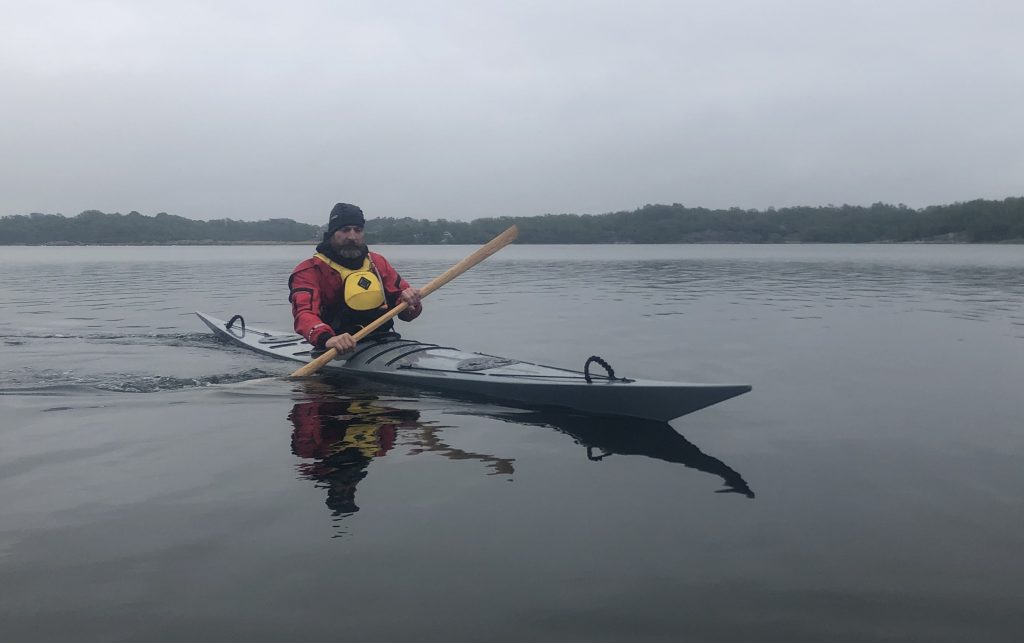
Photo: Jennie Sjöholm
After yesterday’s paddling with some wind and waves, today the Pearl feels totaly calm and reassuring on the flat water. The instability from the very first try-out is completely blown away and it was even possible to look around without experiencing any immediate risk for capsizing.
But looking backwards straight over your shoulder would probably still require a rear-view mirror to be executed safely.
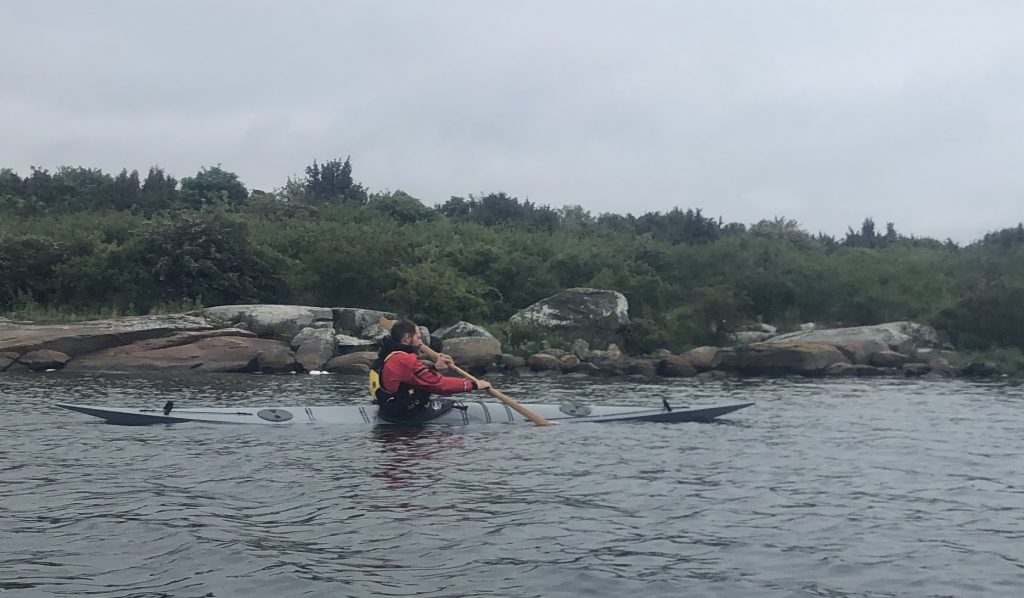
Photo: Jennie Sjöholm
The edging becomes more and more obvious as long as there are no waves to deal with. It works just fine to paddle in decently small figures of eights with no other steering than the tilting.
It feels strange however to have water flowing up over the sheerline already at a moderat tilt, even if i logically understand that this should be normal with this type of kayak. Some acclimatisation is obviously needed before I will be able to treat the Pearl more freely and expressively.
And it does not take that much of a wave size for tilting to be perceived as a bit awkward all togehter. Especially to maintain the edging constantly over several paddle strokes feels particularly venturesome if a slight irregularity emerges among the waves.
I still, even on flat water, get the sensation of that the bow rests a little deep. Like riding a horse with narrow bows, there is not enough in front of you and there is a feeling of tipping forward.
I asked my sister to take a photo in profile to be able to look at this more objectively:
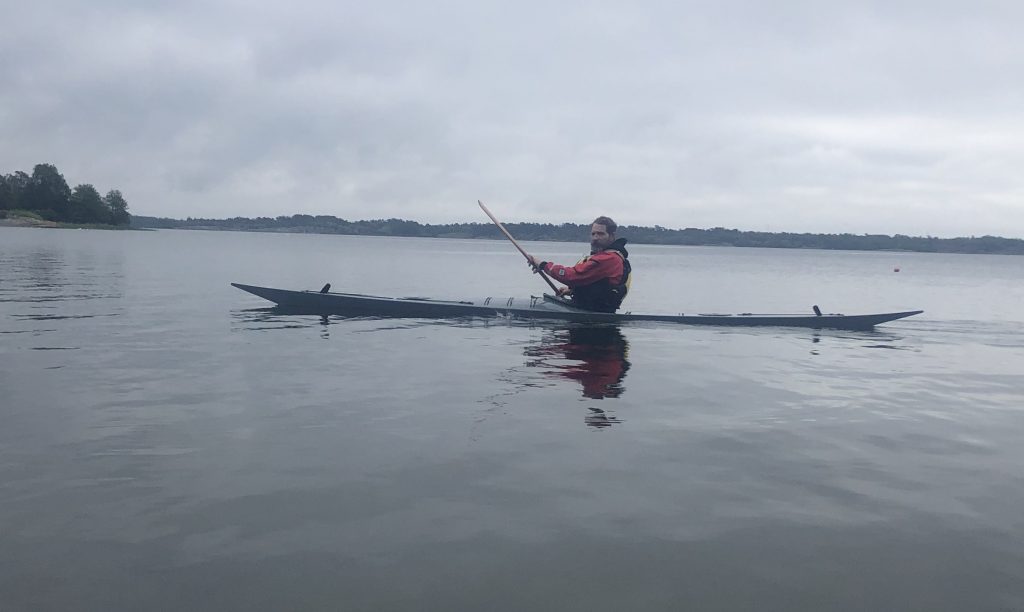
Foto: Jennie Sjöholm
I conclude that it looks quite reasonable and normal. Mere imagination from my side obviously, and a question of detoxication from higher and more voluminous kayaks.
The paddle session for today is also kept short. Partially because I have to concentrate more than normally in the slender Pearl which makes it more mentally tiresom, partially because of the unfamiliar sitting position, with the legs straighter as required by the low deck, which makes paddling more physically fatigueing compared to what I am used to.
Specifically, I tend to experience tendencies for cramps in the iliopsoas muscles, especially when trying to maintain the edging over a longer period of time for the purpose of couteracting the weathercocking of the kayak in beam wind.
The major safety issue where I am right now is probably to end up in conditions that is slightly more demanding than I am capable of physically handle with sufficient alertnes during the required amount of time due to my present unfamiliarity with the Pearl. Cramping thigh muscles does not go away just because you grit your teeth.
There is simply no way around getting gradually used to the new kayak in general, and the sitting position in particular, until I have reached a level where I am ready for longer shifts in the cockpit.
To finish off when back at the home shore, I wanted to try a wet exit. This has been bothering me all since i first tried the Pearl on the workshop floor, since I am relatively stuck in the Pearl compared with my previous kayaks. In them you have to do active work not to fall out when you are upside down, whereas in the Pearl it seems like it will take considerable effort to avoid getting stuck.
This however turned out to be no problem. The legs are easier to pull out than to push in, and the gravitational force works in your favour when upside down.
So now I know with some degree of certainty that I will not be caught in the capsized Pearl. I had otherwise imagined the facial expression of the rescuers salvaging the stray kayak floating bottom up, just to discover that there is a dead guy hanging underneath. Nothing to joke about, i know, but to me this is a strong visual reminder to keep safety first.
Regardless of this successful attempt, it would be wise to practice wet exits regularly with the Pearl, it is not so easy as to just push yourself out.
Instead, I must first push the buttocks sligthly away from the seat, then push them backwards along the deck until the knees come free from the front cockpit edge, and finally push myself outwards again for the somersault to come clear.
Evidently, this requires more coordination and cool-headedness in the Pearl compared to kayaks with larger cockpit openings, three separate steps to perform in the right sequence instead of just letting yourself fall out.
By far, the greatest experience today was however when i after the wet exit came up with the idea to try a re-entry without assistance. This I had assessed as totally impossible in this type of kayak. Little did i know.
Firstly, it turned out to be relatively easy to evacuate almost all water from the cockpit. Without any recesses or edges inside, there is nothing obstructing the water from coming out, and the light weight of the Pearl makes it reasonable to lift the front end while treading water.
Thereafter, it was amazingly unproblematic to slide up on the rear deck, cowboy style. Thanks to the low freeboard it was not as high to climb compared to larger kayaks, and surprisingly enough it did not result in the coaming beeing pushed under water, flooding the cockpit.
This far in the process I have accomplished also in my Dagger, but after this problems arise when balancing on the rear deck trying to get into the cockpit. If it is difficult in the sturdy Dagger, for sure it must be impossible in the unstable Pearl, especially since i must juggle a lot to get my legs into the narrow cockpit hole whereas in the Dagger I can sit down on the seat and then lift the legs inside afterwards..
But despite what I thought was obvious common sense, it was actually much easier in the Pearl. Having a considerably lower rear deck, the center of mass is lowered and you can sit quite well balanced on the rear deck.
The fact that there is almost no water left in the cockpit further increases the stability of the Pearl. The Dagger on the other hand is usually semi filled with water at this stage, partially since it is difficult to evacuate in the first place, partially because it is flooded anyway when i climb up on the rear deck.
All of this resulted in me being back in the dry cockpit withot any trouble at all. In conditions without any wind and waves admittedly, but even so, a much more credible rescue method than I ever could have imagined. Mentally I had alredy taken it out of consideration, but afterwards I am glad that I against better knowlede considered it enough to try it out.
The sister in charge of the camera departement was so amazed by my feat that she completely forgot taking pictures. But I made a replay on the following Sunday to make sure that it was not beginners luck, which resulted in some photos. You will find them if you scroll down below in this post.
The conclusion of this exercise, primarilly to get out of, but also back into, the Pearl is that even if my roll is not sufficiently consistent I can still paddle short distances on my own provided that conditions are close to optimal.
Overall and so far, an overwhelmingly more favourable outcome than I could even have dreamt about.
Observing that a few tablespoons of water has leaked into the forward storage compartement. Have no immediate idea as to where it came in but I have a few alternatives to check. This is not an alarming problem for now, so I leave it for later.
Saturday 2019-06-01: A day for rest
I don’t feel entirely well today, and furthermore the weather is kind of useless. Therefore we decide to rest from paddling in order to be in good shape for tomorrows last chance during this weekend.
Sunday 2019-06-02: Final day
Start of by a morning cruise on my own. Well, morning and morning, it was almost eight when I got on my way, but in my curriculum that is early.
Paddled randomly around for about an hour in the sunshine. Focused on nothing in particular, just wanted to get time in the saddle.
Even in these favourable conditions my iliopsoas muscles bothers me slightly, presently this is the primary constraint for making longer cruises.
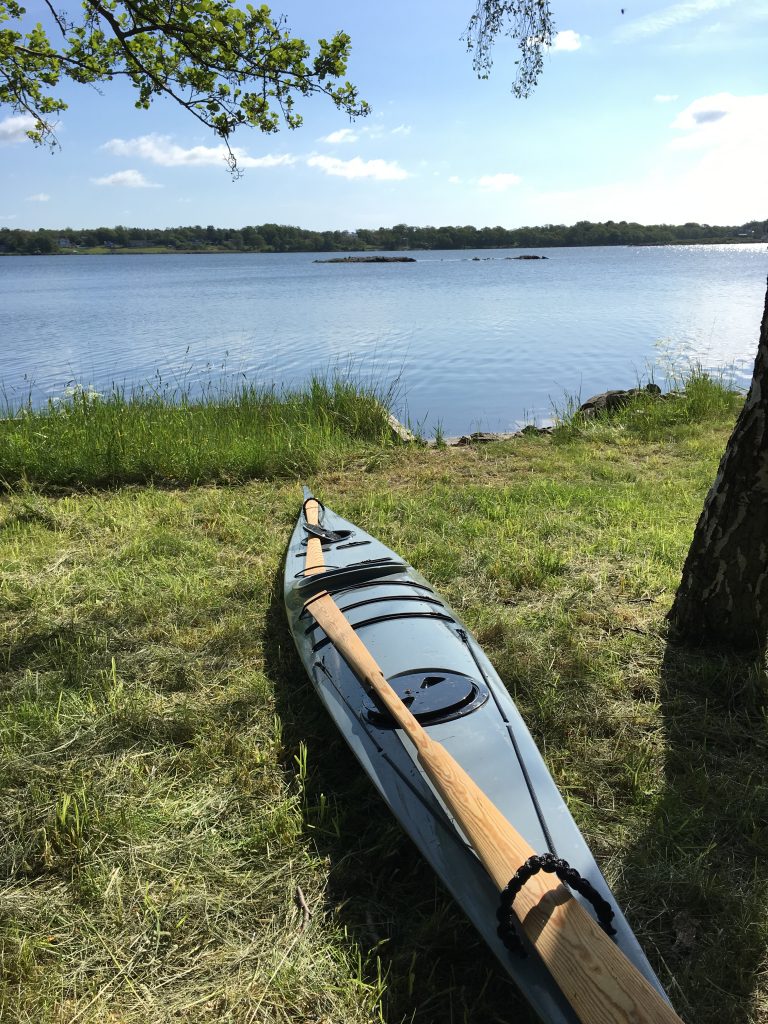
A couple of hours later, also my paddle partner was awake and operational. This resulted in a short expedition, but still the longest one this weekend.
Just over an hour paddling out, headwind, coffe break on a small island, less than an hour back home, tailwind.
The Pearl was not nearly as prone for weathercocking today, despite quite a strong wind for my present capabilities. 7-12 m/s according to the forecast, but I dont believe it was anywhere near 12 even in the gusts.
As an experiment I had placed water bottles, 4,5 kilograms in total, and some coffe gear in the aft storage compartement. This should wheigh down the stern slightly, thereby fixating it firmer into the water and to some extent prevent it from drifting leewards.
However, I don’t think that this minor shift of weight could make that much of a difference, so I prefer to believe that the decreased tendency for weathercocking was partially due to some improvement in my paddling technique compared to the last time we encountered some significant wind.
The key is to compensate for weathercocking early on and not too much. If you wait for the next stroke you have to compensate more, which steals focus from the forward driving and tends to make you over-steer, thus forcing you to steer in the opposite direction at the next stroke. All of this results in a tortuous journy and a lot of energy lost for achieving nothing.
This is also the first time I have had any use of Björn Thomassons advice to continously put all ”weight” on one foot at one side of the footrest. The purpose of this is to create a one-sided pressure which over time counteracts the weathercocking. I have tried this with my other kayaks without experiencing any differance, but obviously the Pearl is more accomodative to the paddlers intents.
The most difficult direction right now seems to be an angled tailwind, I need to straighten out what the difficulty is with this situation.
Also wind straight from the stern and almost surfable waves makes my paddling a bit half-hearted. I experience some problems in coordinating the stern rudder witth edging and balance, sometimes the paddle dig into the water in an unintended manner and the situation becomes uncomfortable for a second.
I obviously have to go back and improve my rudder strokes, so that I immediately get the paddle into steering position without having to search for it.
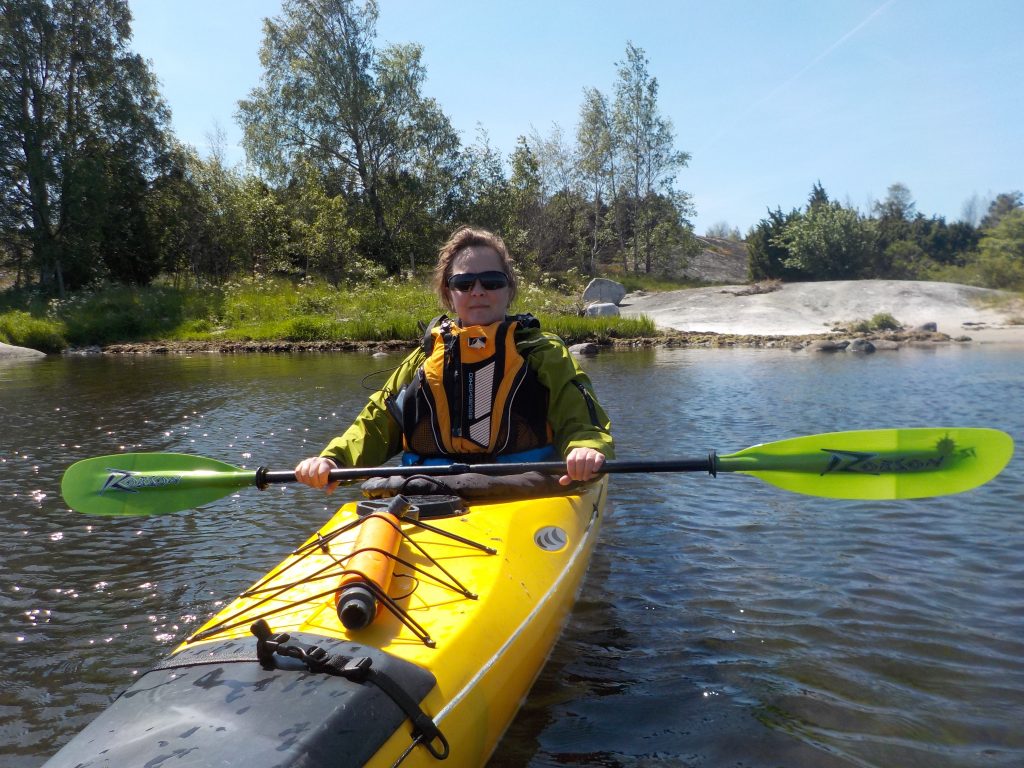
Since there were no pictures from the cowboy rescue the other day, I do it again and make sure Jennie’s camera is at work, see the picture gallery below:

Disaster in progress… 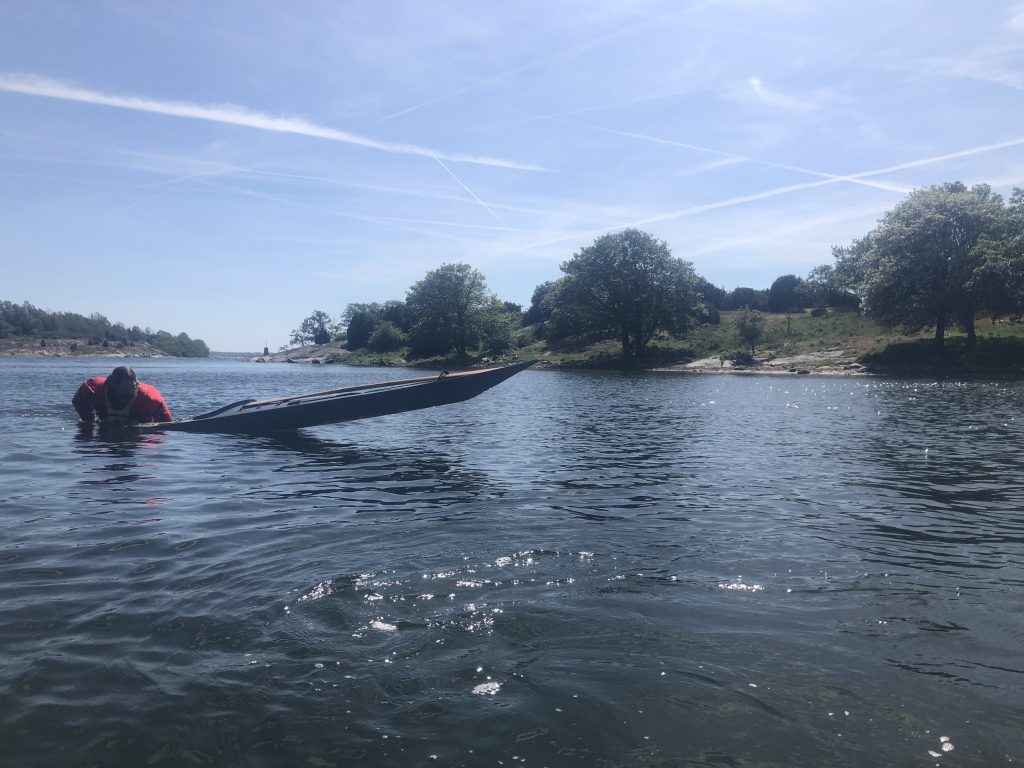
…followed by exit, evacuation of water and sliding sideways up on the rear deck… 
…into a straddle position crawling towards the cockpit… 
…and eventually, with balance assistance from the paddle… 
…becoming temporarily restrained by the exhausted iliopsoas making my legs shiver heavily when trying to lift them over the edge… 
…and the semi-paralysed legs causing some balance issues resulting in water in the cockpit, but after some delay everything work out in the end. 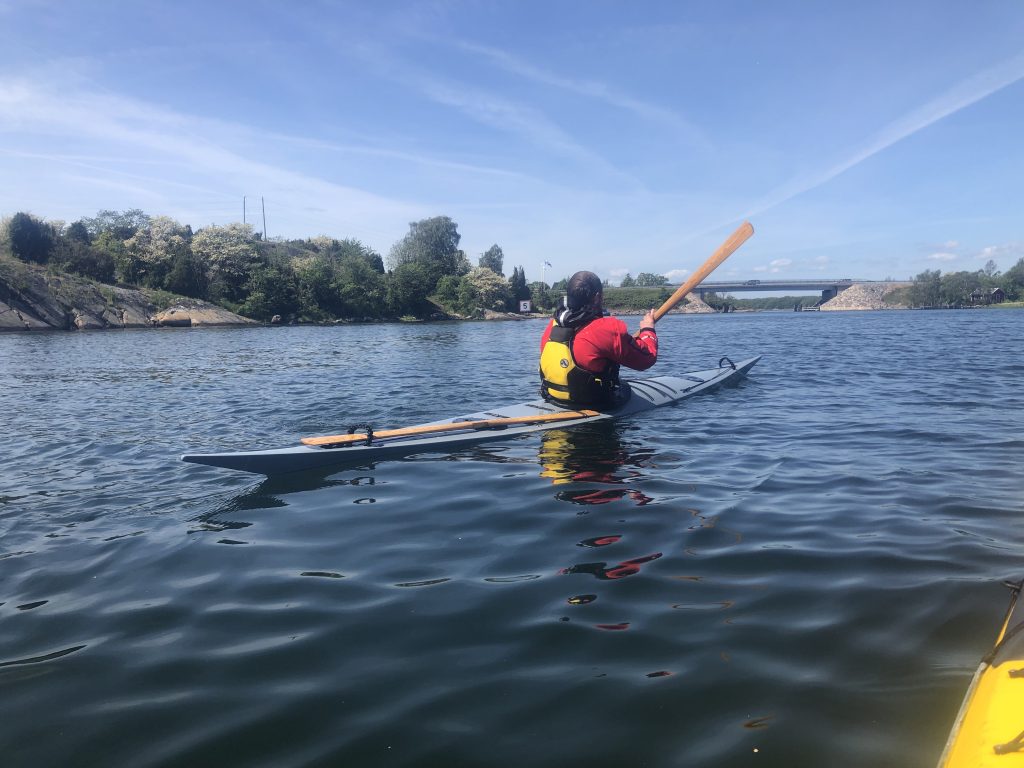
Back in the the driver seat, spray deck reattached and the paddling continues.
Findings and conclusions from the weekend
Below, I will summarize my Black Pearl experiences so far, primarily for my own memory’s sake but to some extent also as an indirect review of the Pearl through the eyes of a first-timer..
Firstly, I would like to emphasize the overwhelmingly positive overall experience during the premiere weekend as a BP paddler.
In this I include the performance anc characteristics of the Pearl as well as the fact that everything went a lot better than I have anticipated.
The initial threshold for coming to terms with the Pearl is significantly lower and the learning curve is considerably steeper than expected.
(To avoid misunderstandings, a steep learning curve means that you learn more things more quickly, not that learning is an up-hill experience.)
To conclude, Black Pearl exceeds all my hopes and expectations, now it is ”merely” up to me to develop my paddle skills enough to take advantage of her potential.
Finally, a list of the issues I have identified during the weekend as primary objectives for the next step of improvement in order to grow into the Pearl:
- Sittinig position. My major constraint for the moment is that I cannot cope with longer cruises due to the iliopsoas muscles bothering me and limits my physical endurance.
For the time beeing I will assume that this is a matter of acclimatisation that will solve iteself as I gain more hours in the cockpit. If this doesn’t help I have to come up with a more active plan. - Get a grip on edging/tilting. Since the Pearl has less initial stability than any other kayak I’ve been into, I need to develop a better intuitive feeling for how much tilting is adequate, and possible, for achievning different manoeuvering purposes. Especially if any waves are present.
- Experiment with low and high braces. I did almost nothing of this sort during the weekend, but these strokes are crucial to get to terms with edging/tilting. The few times I actually tried a more aggreessive brace I got the feeling of falling through, I assume that the demands on technique and timing are higher in a less stable kayak such as the Pearl.
- Rudder strokes! Primarilly the stern rudders, since those are the most basic ones. I have already been paddling a rudder-less kayak for some years now, so stern rudders are of course nothing new to me. But it seems like they should be executed with a bit more precision and subtlety to be appropriate in the Pearl. Consequently, I have to shape up my game in this area.
- Paddle length? Since the seat is lower in the Pearl compared to my previous kayaks, I come closer to the water. As a result, the surface is nearer than my motor skills are accustomed to, and therefore I tend to make a splash when entering the stroke.
Considered to shorten my paddle slightly, but discarded that idea and ended up with the intention to fine tune my stroke coordination instead, and utilize the paddle lenght for entering further forward, facilitating a longer stroke. - Resume systematic roll practice. With a small cockpit opening, rolling would be the prime ”rescue” method in case of capsizing. This requires a much more reliable roll than I have on display right now, meaning that I have some work to do.
Presently, rolls are almost 100% on my right hand side in calm conditions and maybe 50% on the left hand side. I need to be 100% on both sides and in rougher conditions with wind, waves and cold weather.
I cannot get a better tool for developing my rolling skills than the Pearl, so there are no longer any excuses! - Balance brace? Tried this once during the weekend, quite half-heartedly, but sunk through and it turned into roll practice instead. Have never tried a balance brace before and didn’t prepare by creating a mental image of what I was trying to achieve, hence the failure.
This seems like a move that is natural to integrate into roll practise.
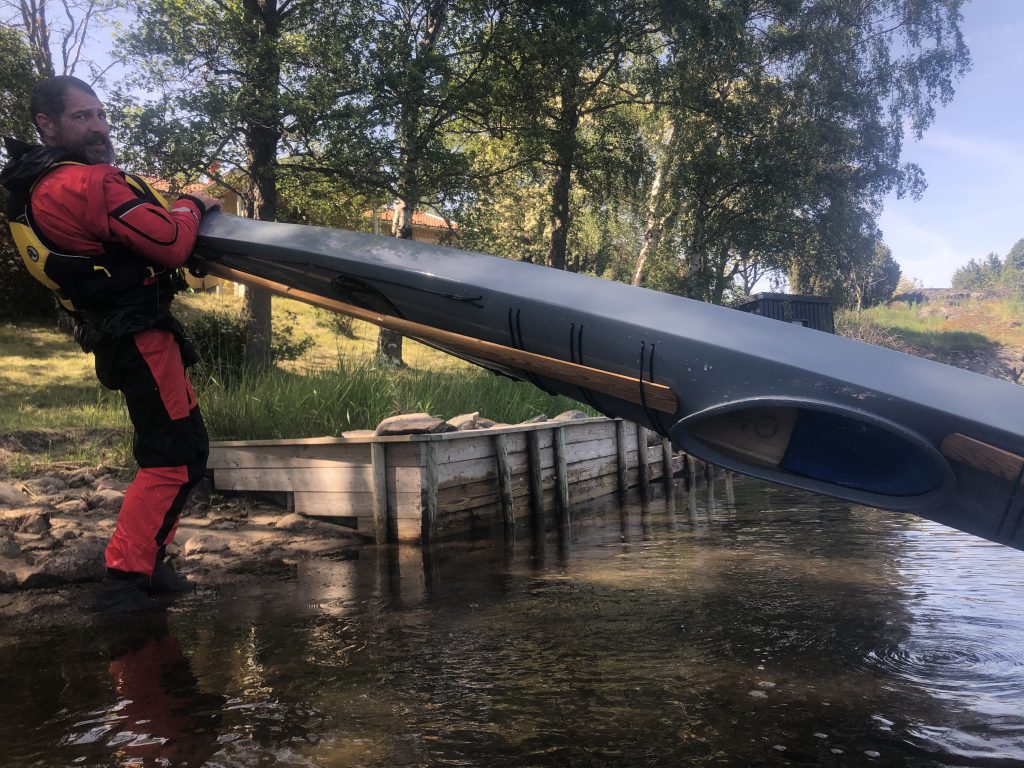
Thats all for now folks, I finish this weekend by evacuating water from the Pearl after the last rescue drill and thanking you for your attention!
And, from my present location home in the couch together with three cuddly cats, I make a note that I have still not capsized involuntary with a kayak.
Good judgement or cowardice?
(Okay, okay, I promise to stop badgering about this, I am just so amazed that this state still remains after the past weekend.)
PS:
Thank you Björn for a formidable kayak design!



Lämna ett svar